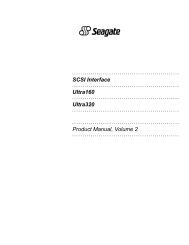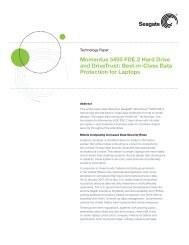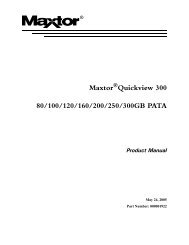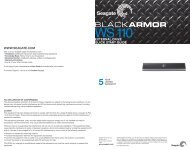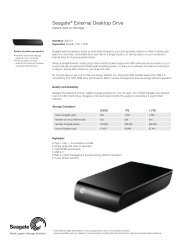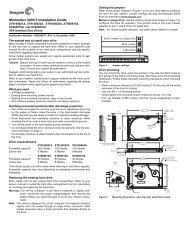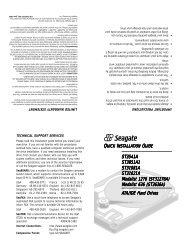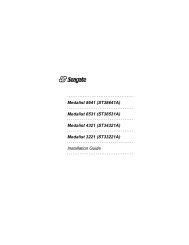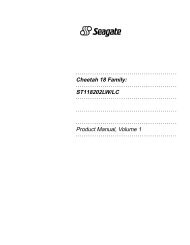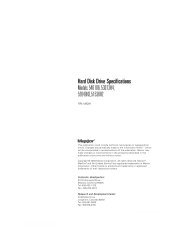Barracuda 18LP Family: ST39175LW/LC ST318275LW ... - Seagate
Barracuda 18LP Family: ST39175LW/LC ST318275LW ... - Seagate
Barracuda 18LP Family: ST39175LW/LC ST318275LW ... - Seagate
You also want an ePaper? Increase the reach of your titles
YUMPU automatically turns print PDFs into web optimized ePapers that Google loves.
<strong>Barracuda</strong> <strong>18LP</strong> Product Manual, Rev. E 11<br />
4.4 Prefetch/multi-segmented cache control<br />
The drive provides prefetch (read look-ahead) and multi-segmented cache control algorithms that in many<br />
cases can enhance system performance. “Cache” as used herein refers to the drive buffer storage space when<br />
it is used in “cache” operations. To select prefetch and cache features the host sends the Mode Select command<br />
with the proper values in the applicable bytes in Mode Page 08h (see SCSI Interface Product Manual,<br />
part number 77738479). Prefetch and cache operation are independent features from the standpoint that each<br />
is enabled and disabled independently via the Mode Select command. However, in actual operation the<br />
prefetch feature overlaps cache operation somewhat as is noted in Section 4.5.1 and 4.5.2.<br />
All default cache and prefetch Mode parameter values (Mode Page 08h) for standard OEM versions of this<br />
drive family are given in Tables 9a and 9b.<br />
4.5 Cache operation<br />
In general, all but 100 Kbytes of the physical buffer space in the drive can be used as storage space for cache<br />
operations. The buffer can be divided into logical segments (Mode Select Page 08h, byte 13) from which data<br />
is read and to which data is written. The drive maintains a table of logical block disk medium addresses of the<br />
data stored in each segment of the buffer. If cache operation is enabled (RCD bit = 0 in Mode Page 08h, byte 2,<br />
bit 0. See SCSI Interface Product Manual, part number 77738479), data requested by the host with a Read<br />
command is retrieved from the buffer (if it is there), before any disc access is initiated. If cache operation is not<br />
enabled, the buffer (still segmented with required number of segments) is still used, but only as circular buffer<br />
segments during disc medium read operations (disregarding Prefetch operation for the moment). That is, the<br />
drive does not check in the buffer segments for the requested read data, but goes directly to the medium to<br />
retrieve it. The retrieved data merely passes through some buffer segment on the way to the host. On a cache<br />
“miss”, all data transfers to the host are in accordance with “buffer-full” ratio rules. On a cache “hit” the drive<br />
ignores the “buffer-full” ratio rules. See explanations associated with Mode page 02h (disconnect/reconnect<br />
control) in the SCSI Interface Product Manual.<br />
The following is a simplified description of a read operation with cache operation enabled:<br />
Case A - A Read command is received and the first logical block (LB) is already in cache:<br />
1. Drive transfers to the initiator the first LB requested plus all subsequent contiguous LB’s that are already in<br />
the cache. This data may be in multiple segments.<br />
2. When a requested LB is reached that is not in any cache segment, the drive fetches it and any remaining<br />
requested LBs from the disc and puts them in a segment of the cache. The drive transfers the remaining<br />
requested LBs from the cache to the host in accordance with the disconnect/reconnect specification mentioned<br />
above.<br />
3. If the prefetch feature is enabled, refer to Section 4.5.2 for operation from this point.<br />
Case B - A Read command requests data, the first LB of which is not in any segment of the cache:<br />
1. The drive fetches the requested LB’s from the disc and transfers them into a segment, and from there to<br />
the host in accordance with the disconnect/reconnect specification referred to in case A.<br />
2. If the prefetch feature is enabled, refer to Section 4.5.2 for operation from this point.<br />
Each buffer segment is actually a self-contained circular storage (wrap-around occurs), the length of which is<br />
an integer number of disc medium sectors. The wrap-around capability of the individual segments greatly<br />
enhances the buffer’s overall performance as a cache storage, allowing a wide range of user selectable configurations,<br />
which includes their use in the prefetch operation (if enabled), even when cache operation is disabled<br />
(see Section 4.5.2). The number of segments may be selected using the Mode Select command, but the size<br />
can not be directly selected. Size is selected only as a by-product of selecting the segment number specification.<br />
The size in Kbytes of each segment is not reported by the Mode Sense command page 08h, bytes 14 and<br />
15. The value 0XFFFF is always reported. If a size specification is sent by the host in a Mode Select command<br />
(bytes 14 and 15) no new segment size is set up by the drive, and if the “STRICT” bit in Mode page 00h (byte<br />
2, bit 1) is set to one, the drive responds as it does for any attempt to change unchangeable parameters (see<br />
SCSI Interface Product Manual, part number 77738479). The drive supports operation of any integer number<br />
of segments from 1 to 16.



